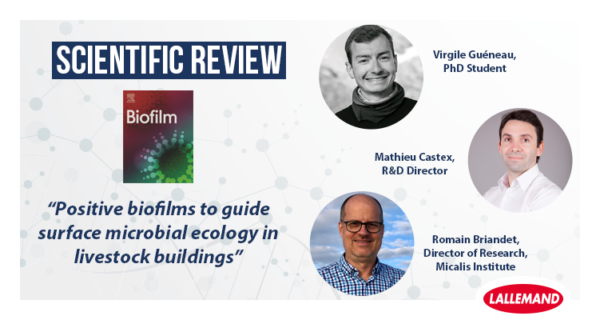News | Reading Time 4 minutes
New publication helps sample and study biofilms in livestock buildings
Biofilms are omnipresent around farm animals and can harbor beneficial or undesirable microorganisms. Researchers are just beginning to understand their importance in the maintenance of animal health and performance. However, there is currently a lack of knowledge and standardized method to study biofilms in a farm setting.
A recent publication bridges this gap and describes a reproducible, non-destructive method to sample and study biofilms on farm building surfaces (Guéneau, et al., 2022). This publication brings some of the primary data on biofilm formation in a pig farm*. It confirms active bacteria remain on the animal environment surfaces following a standard cleaning and disinfection protocol and that the surface material plays a role in biofilm development.
Why study biofilms?
A biofilm is defined as a “spatially organized community of microorganisms fixed to a surface.” It secretes a protective extracellular matrix, which can represent around 85% of the biofilm biomass. A biofilm can be formed either by beneficial or by undesirable bacteria. In farm buildings, all surfaces — floors, walls, ceilings, and equipment — are colonized by biofilms. They can be harmless, positive, or negative for the animals if they contain pathogens. Before a new batch of animals enters the building, cleaning and disinfection are necessary. However, surfaces do not remain sterile. Microorganisms carried over from the animal environment and the new animals themselves quickly start recolonizing the surfaces, forming biofilms.
Main conclusions of the study
Guéneau’s research describes a new, standardized, non-invasive method to sample and study bacterial biofilms in the farm environment. In addition, this publication confirms the importance of biofilms around housed animals:
- Two days following cleaning and disinfection, there is the presence of active bacteria, able to reproduce, on the surfaces (4 log CFU/cm2). This concentration of bacteria may come from the residual biofilm not having been affected by cleaning/disinfection and its growth on the surface during these two days. This recolonization confirms the cleaning and disinfection procedure has no long-term effect.
- The surface material has an influence: The study used PVC and steel coupons, two materials used in pig farms. Looking at the total biovolume on coupons using confocal laser scanning microscopy, more biofilm is formed on steel than on PVC surface in the same period, which can be explained by the material surface characterization. Steel presents hydrophilic properties and harbors holes and cracks where bacteria can more easily adhere compared to PVC.
- On the contrary, looking at the cultivable bacteria counts, showed higher colonization in the number of bacteria for PVC compared to a steel surface (on average, 6 log CFU/cm² for PVC and 5 log for steel).
- Following the entrance of the animals into the building, a surface biofilm rapidly forms with the increase in bacteria counts. Using 16s rRNA, researchers describe the microbial community on surfaces around animals with a probable correlation existing between the composition of the animal microbiota and the microbial communities identified on the coupons.
At the same time, the use of this methodology helps assess the implementation of a positive biofilm solution (LALFILM PRO from Lallemand) after disinfection to better manage surface microbial ecosystems. Research is ongoing and will soon be published (Rodiles et al, 2021).
Published Mar 28, 2022 | Updated May 29, 2023





